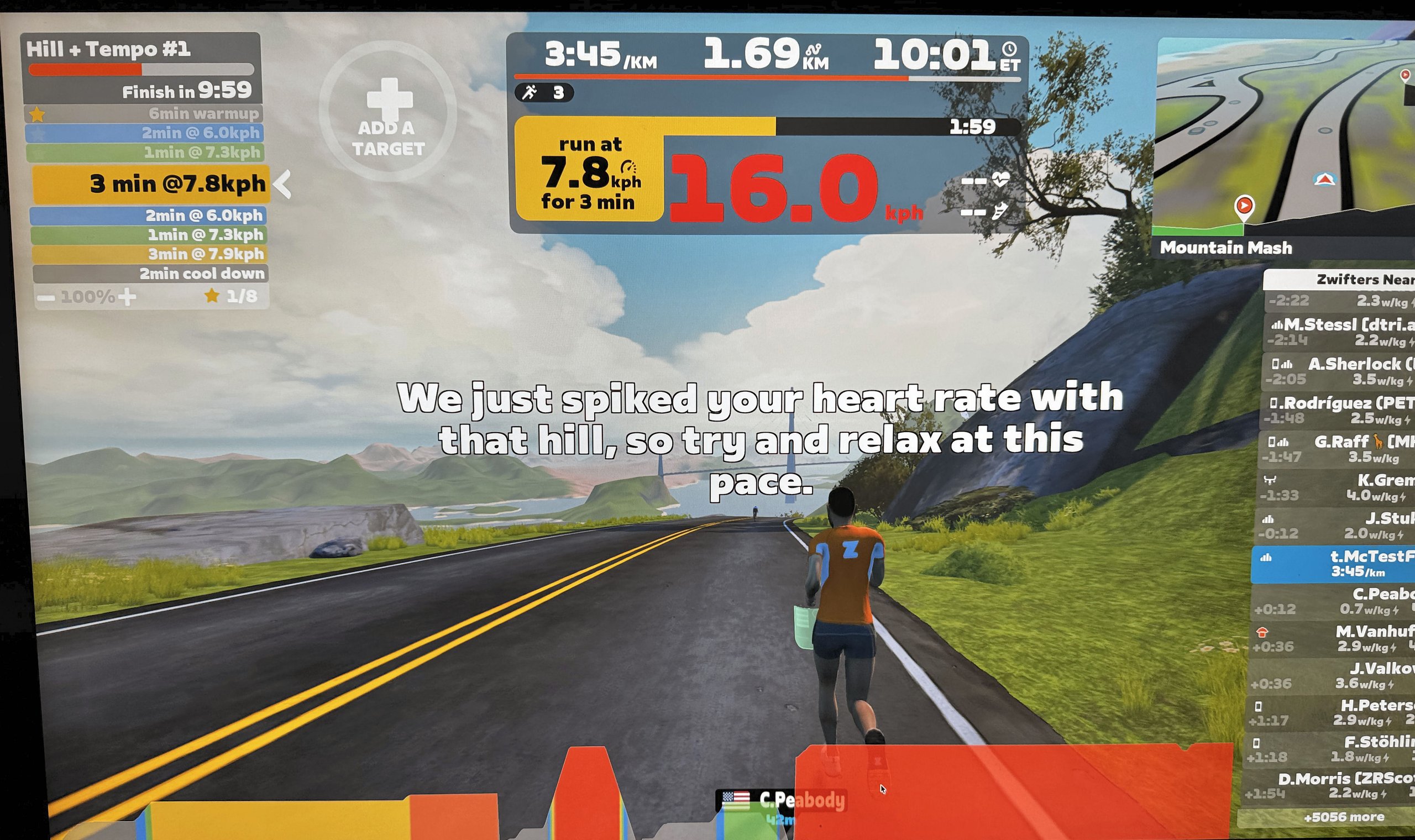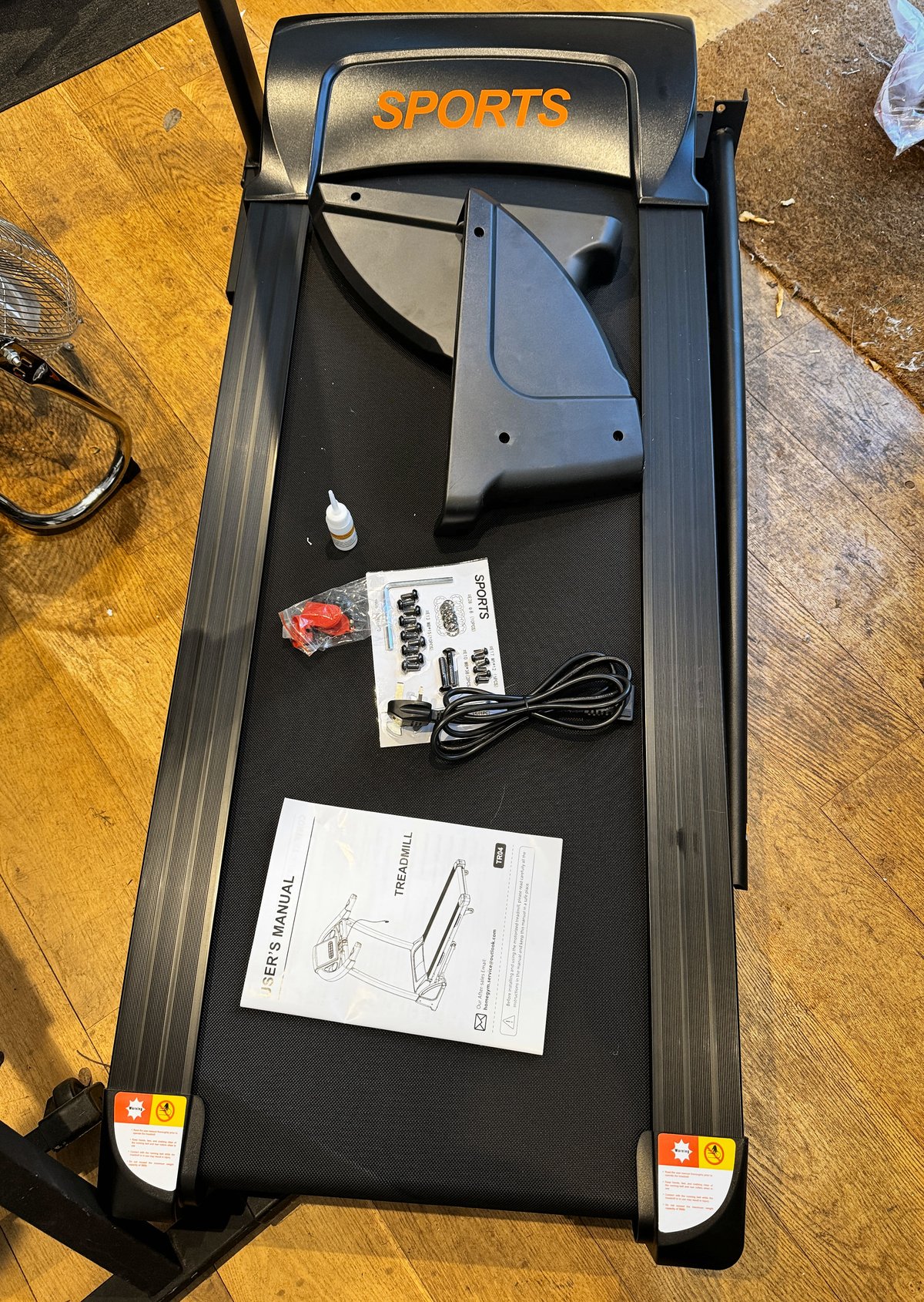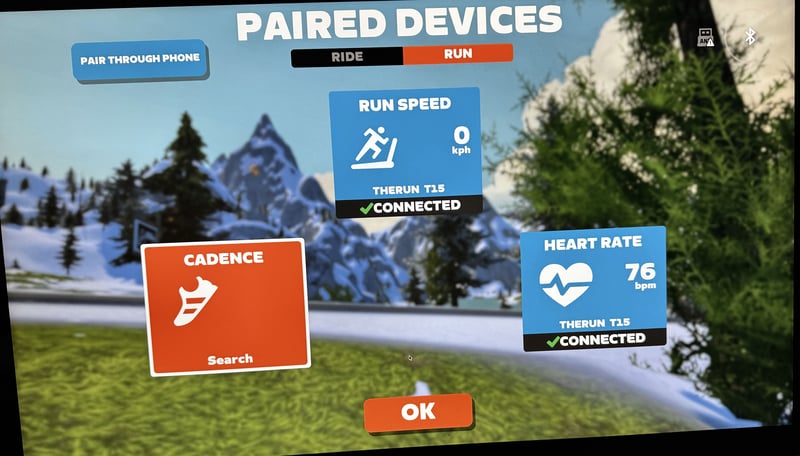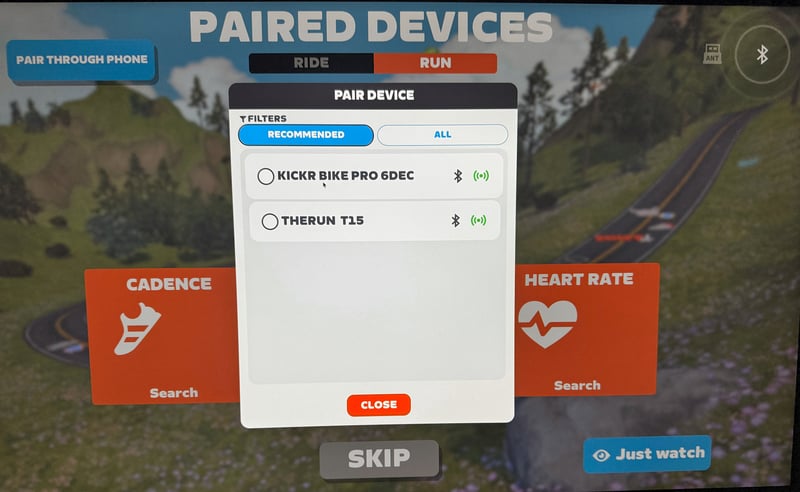
THERUN T15 Auto Incline Treadmill Review – space saver, Zwift compatible
If you are a 30-minute parkrunner or power walker, this is a great home treadmill
Summary
THERUN’s T15 treadmill is a step up from basic home walking plates. It is suitable for most recreational runners up to a max of 1:41:00 in the Half Marathon, and for all walkers except those specifically looking to walk at steep inclines above 11%.
The treadmill certainly has its faults, but none are showstoppers unless you count the missing tablet holder as one. The slightly overstated speed and underpowered motor are not unusual at this price point; the big bonus here is the foldaway design.
You can pay $5,000 for a top-end treadmill, so one that’s less than $500 isn’t going to be as good. THERUN appears well-made to last for years and compatible enough to support a rich training experience with one of the current generation of excellent training apps like Zwift (free).
I’m a decent runner and triathlete, and I have no problems using this treadmill for my long, slow weekend runs in the winter. But it’s better suited to other family members who want the occasional ease of running from home.
Pros
- Space Saver/Portability: Folds easily, reducing floor space by half for storage. It has wheels for moving (though pushing is difficult).
- Zwift Compatible: Features Bluetooth 5 connectivity for use with Zwift (free), MyWhoosh (free), Kinomap, and many others.
- Noise: Quiet for walking (53dB)
- Solid Build Quality: Sturdily made with a steel frame, surprising for an entry-level product.
- Effective Incline: The 10% maximum incline is functional and steep enough for walkers.
- Good Cushioning: Features a decent shock absorption system, which is better than running on the road for those with injuries.
- Assembly: Straightforward assembly, largely pre-assembled, taking about 30 minutes.
Cons
- Motor Underpowered: The 1.25 CHP motor is low-powered but similar to competitors
- Inaccurate Running Speed: Reported running speeds are overstated (up to 2.2 km/h difference at 16 km/h).
- Running Noise: Reaches up to 80dB on hard surfaces, which could be an issue in apartments.
- Display Quality: The control panel and display are “rudimentary” and look “like something from the 1980s” with poor, plasticy buttons.
- Incorrect Specs: The manufacturer’s claims for maximum incline (15% vs. 10%) and maximum HP (3.5 HP vs. 1.25 CHP) are misleading.
- Heart Rate Sensor: Inaccurate at higher speeds, and only practical as a simple “heart rate check” for walkers.
- No Tablet Holder: Lacks a secure place to hold a tablet, a significant omission given its Zwift compatibility, unless you use a TV.
Who is the THERUN T15 Budget Folding Treadmill For?
THERUN is designed for recreational runners and walkers who want a robustly built indoor treadmill that folds for space-saving storage.

I need to quickly emphasise the recreational aspect of this product. These are the types of runners it suits
- Runners of a maximum ability 22:00/5km, 1:41:00 HM, I’ll explain that in more detail later on.
- Walkers who want a maximum incline of 10%
- Weight max 300lbs/135kg (manufacturer claims)
- Anyone who wants basic compatibility with Zwift, Mywhoosh, apps or sports watches.
More: My Perfect Zwift Setup
THERUN T15 Design, Build Quality, and Core Specs
This is a sturdily made indoor treadmill. I was actually pleasantly surprised by the build quality. The load-bearing parts are made of steel, and as a test, I could easily support my entire weight on the handrails without flexing the frame. Similarly, when running, I run fairly heavily for a 73kg runner; it felt solid underfoot. So it should, as it is designed for someone twice my weight (300 pounds, 135kg).
The next thing to remember is that this is much smaller than a gym-grade treadmill. When assembled, it covers 60″D x 30″W x 51″H. I measured the belt at 17″ x 47″, so that’s long enough for everyone but narrower than the ones you might be used to in gyms.
Perhaps more importantly, the folded dimensions are 29.5″D x 31.5″W x 54.7″H. That’s not super-small, but it effectively reduces the floor area needed by half.
I’ll get into the motor performance in a minute, but you need to note that this is the area where the company has compromised to reduce costs.
You’ve already seen pictures of THERUN, so you’ll know it has a rudimentary display, 2 cup holders and a bit of storage space. On the handrails are additional controls for incline, speed, and to periodically take a heart rate measurement – great for walkers, rubbish for runners.
Aesthetics: Display Console and Low-Quality Plastic Components
I mean, it’s a treadmill. They all look relatively similar. It’s black with a few orange details. Getting a little closer, you would notice the lower quality plastic components, namely the entire display and the controls on the handrails.
THERUN T15 Performance: Actual Motor Power and Speed Accuracy Test
I looked at several of the treadmill’s performance characteristics and quantified the incline accuracy, speed accuracy, and noise levels.

Foldability Test: Space-Saving Folding Treadmill Dimensions
I measured THERUN to agree with its claimed sizes
- Unfolded dimensions: 60″D x 30″W x 51″H.
- Folded dimensions: 29.5″D x 31.5″W x 54.7″H – half the floor area compared to unfolded
- The belt measures: 17″ x 47″ – long enough for everyone but narrower than the ones you might be used to in gyms.
Running Speed Accuracy Test Results (Weighted vs. Unweighted)
Methodology: I used an accurate, treadmill speed tool (NPE RUN), which reported speed, incline and cadence to a separate recording device. I increased the belt speed according to THERUN in 1.0km/h increments and recorded the actual belt speed moving freely and moving with me on it. I allowed 10 seconds for the belt speed to stabilise.
| Reported Belt Speed (km/h) | NPE Runn Speed (unweighted) | NPE Runn Speed (74.4kg weighted) | Diff |
| 1.00 | 1.00 | 0.90 | 0.10 |
| 2.00 | 2.00 | 1.90 | 0.10 |
| 3.00 | 3.00 | 2.80 | 0.20 |
| 4.00 | 4.00 | 3.80 | 0.20 |
| 5.00 | 5.00 | 4.80 | 0.20 |
| 6.00 | 6.00 | 5.80 | 0.20 |
| 7.00 | 6.80 | 6.60 | 0.40 |
| 8.00 | 7.60 | 7.40 | 0.60 |
| 9.00 | 8.40 | 8.20 | 0.80 |
| 10.00 | 9.20 | 9.00 | 1.00 |
| 11.00 | 10.00 | 9.70 | 1.30 |
| 12.00 | 10.80 | 10.50 | 1.50 |
| 13.00 | 11.70 | 11.30 | 1.70 |
| 14.00 | 12.50 | 12.10 | 1.90 |
| 15.00 | 13.40 | 12.90 | 2.10 |
| 16.00 | 14.20 | 13.80 | 2.20 |
Note 16.0km/h is 10mph. 5.0km/h is about 3mph.
The response time to a 1km/h speed change was between 2 and 4 seconds.
Normal walking speed is about 4-6km/h, and you can see THERUN is quite accurate there. However, it struggles to get the unweighted belt speed correct, presumably due to incorrect factory calibration, and it struggles even more when I run on it. The additional inaccuracies from the latter are caused by the low-powered motor struggling to maintain the speed. If you weigh more than 74.4kg, this effect will likely be greater.
Broadly speaking, the walking speeds are sufficiently correct, but the reported running speeds are overstated.
Auto Incline Accuracy Test: 10% Actual Incline (Not 15%)
I used a digital ‘spirit level’ to determine that the floor was perfectly level. The level showed that the treadmill was inclined at 1.2% by default, rising to 11.2% at its maximum setting. Ie the incline increases by 10%.
It takes about 4 seconds for the treadmill to change by 1% when you adjust the incline. It did this smoothly and took just over 40 seconds for the full 10% change – either up or down, it took the same amount of time.
I was happy with the incline’s overall performance. Typically, you would set a treadmill to 1% to simulate outdoor air resistance, so the 1.2% starting incline is fine, as long as you realise that. I’m not convinced the manufacturers intended this, but it’s good nevertheless.
The specs state THERUN has a maximum incline of 15%. This is incorrect. It’s 10%. That’s still fairly steep.
Handrail Heart Rate Sensor Accuracy Results (Walk vs. Run)
The heart rate seems broadly accurate at walking levels, but underreported when running.
THERUN T15 Motor Noise and Overall Running Volume (dB Test)
The manufacturer claims ‘Quiet dual Motors’
If you have a wooden floor and live in a flat with neighbours below and run at 16.0km/h or 10mph, then you are going to fall out with your neighbours very quickly. If you are walking at 4.0km/h with a 10% incline whilst watching TV for extended periods, your neighbours probably won’t realise how hard you are trying.
Using the NIOSH sound app (iOS), the base noise with no one on the treadmill is low (53dB) and increases along with the belt speed (to 70dB). When running, the additional noise will depend on your running style and weight. Your floor surface and other acoustic factors will make a considerable difference to the noise levels and their transmission. The maximum noise level I got to on a hard surface was 80dB, which is similar to a washing machine or vacuum cleaner. A mat lowers the sound level by up to 5dB – not so much.
| Noise Test | Surface | Unweighted | Weighted (74.4Kg) |
| Background | – | 29dB | 29dB |
| @4km/h | Hard wood | 53dB | 70dB |
| @16km/h | Hard wood | 65dB | 80dB |
| @4km/h | Pro Mat | 51dB | 68dB |
| @16km/h | Pro Mat | 62dB | 75dB |
Actual Motor Rating: 1.25 CHP Continuous Horsepower
The manufacturer advertises a 3.5HP motor on the treadmill. Motor power is important, but the figure quoted is slightly misleading. Here’s why.
I did a bit of research and found that the motor is rated at 1.25 HP for continuous use (CHP) and has a peak power of 3.5 HP. This would contrast with a top-end gym-grade motor like WAHOO KICKR RUN with a 3.0 HP continuous motor and a 7.0 HP peak rating. The CHP value is the one commonly used to compare treadmills.
Why it matters: a lower-powered motor gives this.
- Slower to reach the correct speed when adjusting speeds
- Slower to return the belt to the correct speed when you are running and are entirely in the air (after toe-off)
- Slower to adjust the incline
- Harder to perform with heavier people
- Potentially shorter life.
That said, the 1.25CHP motor is not unreasonable at this price level for the target audience. Aside from the potentially shorter lifespan, which I can’t test, the motor does a good enough job for the target buyer.
Simple Operation and Pre-Set Workout Programs
Let’s assume you want to quickly get on the treadmill at home and watch TV or listen to music. All you need from the treadmill is the ability to manually control its speed and incline, or to follow a simple workout.
Manual control is easy. There are preset speeds that can be enabled by the press of a physical button, eg the 10km/h button or the 4% incline button. You can fine-tune speeds and inclines using the buttons on the main display or the buttons at the ends of the handrails during a workout.
There are two types of programs. One aims for a calorie, distance or time target. The other are preset routines that automatically set the gradient and speed – for example, you might have a steady run interspersed with several higher speed intervals of 1-minute.
Connectivity and Integrated Sensors for Zwift and Apps
Heads Up: This is a relatively basic trainer. Do not expect 3rd party apps to be able to control it in any way other than manually.
When your app or sports device searches for a new sensor, it will see something similar to “THERUN T15”; it might show as a treadmill or footpod.

Bluetooth 5.x Connectivity for Speed and Heart Rate
The treadmill itself broadcasts three types of information to compatible apps and devices. It transmits speed (incline, claimed, not proven) and heart rate using Bluetooth 5.x.
I tested supported connectivity profiles using nRF Connect (iOS).
Integrated Heart Rate Sensor Limitations
In addition to a speed/incline sensor, there is a heart rate sensor. The heart rate sensors require one hand to be placed on the sensor area at the end of each handrail.
The heart rate sensor is only practical at low speeds, and even then, there will be gaps in the data whenever you take one or both of your hands off. It’s essentially a heart rate check. The heart rate values appeared accurate below 100 bpm, but underreported at higher running speeds.
Recommended: Use a cheap Polar Verity SENSE heart rate band on your biceps
Zwift, MyWhoosh, and Kinomap App Integrations
The manufacturer does not produce an app, but that’s no problem, as there are plenty of compatible apps out there – many of them free.
The Zwift app is the best known, and so far, it has always been free to use for running, which is cool. Zwift has you running in a digital world. Still, an interesting alternative is Kinomap (subscription required). This is my partner’s favourite, and you can run along to videos of real-world places.
My Whoosh is another free alternative, and my testing was with that and Zwift. Neither pair to the treadmill immediately, but once paired, they retain a connection throughout the workout.
More: Mywhoosh Review
Running Experience, Ergonomics, and Deck Size Comfort
Overall, you are getting an acceptable experience, which is commensurate with the price you are paying.
Deck Size and Stride Comfort
The Deck Length and Belt Length are both 47.2 Inches, and the Deck Width is 17 Inches. This is fine for most people, but if you stray from side to side, you might have problems – I didn’t. Other reviews talk about all runners and other things; those points are irrelevant. All that matters is your running speed, and this treadmill is targeted at slower (sorry!) recreational runners.
The 5-layer, textured running board offers decent traction thanks to its non-slip surface.
The manufacturer claims a double-shock absorption system with 10 internal shock absorbers. I’d say it’s a relatively hard run but with sufficient ‘give’. Definitely better than running on the roads for anyone with an injury and mindful of impact shock.

Control Panel and The Lack of a Tablet Holder
The control panel area has space for two drink bottles, but isn’t set up to securely hold a tablet – a significant omission considering the brand wants us to use Zwift. Of course, if you run Zwift on Apple TV 4K or similar, you won’t need a tablet, but even then, it might be nice to have somewhere to put a phone.
Other than that, the control panel looks like something from the 1980s. Very basic. The buttons have a poor, plasticy touch when pressed, but they work.
Assembly, Easy Folding Storage, and Value
Let’s look at the practical aspects of the treadmill.

Assembly Time and Easy Setup Process
When the treadmill arrives, it will likely be dropped in your hallway. At 45kg, the box is too heavy for one person to move. It’s securely packed. The assembly takes about half an hour and is straightforward. It’s largely pre-assembled, and it’s pretty obvious where everything goes. There are about 20 screws to tighten. There’s also some oil (supplied) that you apply to the underside of the belt during setup, then every few hundred miles.
Most of my assembly time was spent getting it to the correct location.

Portability and Soft-Drop Hydraulic Folding Storage
Despite its weight, once folded, the treadmill can be tilted onto its wheels and pulled to a different (storage) location. Pushing it is quite a bit more difficult.
One in the correct location, pulling down the running board is easy. Inbuilt hydraulics gently lower it to a flat position as you start moving it. You have to slightly move a rod on the underside of the treadmill to free up its movement.
When you’ve finished with it, it’s simply a case of raising the rear end to a near vertical position – it’s not heavy when it pivots. The whole time required for stowing or unstowing is about a minute.

Durability and Amazon Returns Policy
It seems well-made, but I haven’t tested its long-term durability. To offset that there’s the benefit of buying from Amazon where there are good returns policies.
Treadmill FAQ: Your Questions on the THERUN T15 Answered
- Is the THERUN Auto Incline Treadmill Zwift compatible? Yes, it broadcasts speed and heart rate via Bluetooth 5.x, which Zwift (Run), Mywhoosh, Kinomap, and other apps and devices can readily connect to.
- What is the maximum incline? The maximum tested incline is 10%, not the 15% claimed by the manufacturer. The base incline is 1.2% (11.2% total)
- How loud is the THERUN treadmill? Noise levels range from 53dB (walking) to 80dB (running) on a hard floor. It is generally quiet for walking and louder the faster the run and the heavier you are.
- What is the continuous horsepower (CHP) of the motor? The motor is rated at 1.25 CHP and has a peak rating of 3.5 HP.
- Is the running speed accurate? Walking speeds (4-6 km/h) are generally accurate. Running speeds are overstated, with a measured difference of up to 2.2 km/h at higher speeds.
- What is the maximum run speed? The maximum measured speed is 14.2km/h or about 9mph. This is a relatively fast, steady-state speed for a recreational runner; however, if you are planning to do intervals, 14.2km/h is not fast and would equate to the interval speed a 1:41:00 HM runner would undertake in training. (ask below if that doesn’t make sense)
- What are the folded dimensions? The folded dimensions are 29.5″D x 31.5″W x 54.7″H, effectively reducing the floor area needed by half.
- Is the deck size adequate for running? Yes, the belt is 17″ x 47″. This is narrower than gym treadmills but sufficient for most recreational runners and walkers.
- What is the maximum user weight? The manufacturer claims a maximum weight of 300 lbs / 135 kg.
Take Out
THERUN’s T15 treadmill is a step up from basic home walking plates. It is suitable for most recreational runners up to a max of 1:41:00 in the Half Marathon, and for all walkers except those specifically looking to walk at steep inclines above 11%.
The treadmill certainly has its faults, but none are showstoppers unless you count the missing tablet holder as one. The slightly overstated speed and underpowered motor are not unusual at this price point; the big bonus here is the foldaway design.
You can pay $5,000 for a top-end treadmill, so one that’s less than $500 isn’t going to be as good. THERUN appears well-made to last for years and compatible enough to support a rich training experience with one of the current generation of excellent training apps like Zwift (free).
I’m a decent runner and triathlete, and I have no problems using this treadmill for my long, slow weekend runs in the winter. But it’s better suited to other family members who want the occasional ease of running from home.




